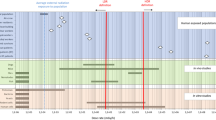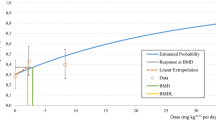Abstract
The possible cancer risks caused by ionizing radiation doses of ~1 mSv or less are too small to be estimated directly from epidemiological data. The linear no-threshold (LNT) approach to estimating such risks involves using epidemiological data at higher (but still low) doses to establish an “anchor point”, and then extrapolating the excess cancer risk linearly down from this point to the low dose of interest. The study in this issue by Professor Tubiana and colleagues, summarizing a French Academy of Sciences report, argues that such LNT extrapolations systematically give substantial overestimates of the excess cancer risk at very low doses. We suggest that, to the contrary, even if there are significant deviations from linearity in the relevant dose range, potentially caused by the effects of inter-cellular interactions or immune surveillance, we know almost nothing quantitatively about these effects. Consequently, we do not know the magnitude, nor even the direction of any such deviations from linearity—the risks could indeed be lower than those predicted by a linear extrapolation, but they could well be higher.
Similar content being viewed by others
References
Tubiana M, Aurengo A, Averbeck D, Masse R (2006) Recent reports on the effect of low doses of ionizing radiation and its dose–effect relationship. Radiat Environ Biophys 44. DOI 10.1007/s00411-006-0032-9
Tubiana M, Aurengo A, Averbeck D, Bonnin A, Le Guen B, Masse R, Monier R, Valleron AJ, de Vathaire F (2005) Dose–effect relationships and estimation of the carcinogenic effects of low doses of ionizing radiation. Institut de France Académie des Sciences, Paris. (www.academie-sciences.fr/publications/rapports/pdf/dose_effet_07_04_05_gb.pdf)
Rossi HH, Kellerer AM (1972) Radiation carcinogenesis at low doses. Science 175:200–202
Brenner DJ, Doll R, Goodhead DT, Hall EJ, Land CE, Little JB, Lubin JH, Preston DL, Preston RJ, Puskin JS, Ron E, Sachs RK, Samet JM, Setlow RB, Zaider M (2003) Cancer risks attributable to low doses of ionizing radiation: assessing what we really know. Proc Natl Acad Sci USA 100:13761–13766
Mole RH (1990) Childhood cancer after prenatal exposure to diagnostic X-ray examinations in Britain. Br J Cancer 62:152–168
Coppola M, Eickel R, Fitzgerald M, Pirrwitz D, Porro F, Booz J (1976) Experimental evaluation of the spectral energy deposition in small volumes by low-LET radiations. In: Booz J, Ebert HG, Smith BGR (eds) Proceedings, Fifth Symposium on Microdosimetry. CEC, Luxembourg
Doll R, Wakeford R (1997) Risk of childhood cancer from fetal irradiation. Br J Radiol 70:130–139
Folkman J (2003) Fundamental concepts of the angiogenic process. Curr Mol Med 3:643–651
Bhowmick NA, Moses HL (2005) Tumor–stroma interactions. Curr Opin Genet Dev 15:97–101
Barcellos-Hoff MH (2005) Integrative radiation carcinogenesis: interactions between cell and tissue responses to DNA damage. Semin Cancer Biol 15:138–148
Brenner DJ, Little JB, Sachs RK (2001) The bystander effect in radiation oncogenesis: II. A quantitative model. Radiat Res 155:402–408
Black WC, Welch HG (1993) Advances in diagnostic imaging and overestimations of disease prevalence and the benefits of therapy. N Engl J Med 328:1237–1243
Bonmassar E, Menconi E, Goldin A, Cudkowicz G (1974) Escape of small numbers of allogeneic lymphoma cells from immune surveillance. J Natl Cancer Inst 53:475–479
De Boer RJ, Hogeweg P (1985) Tumor escape from immune elimination: simplified precursor bound cytotoxicity models. J Theor Biol 113:719–736
Sachs RK, Chan M, Hlatky L, Hahnfeldt P (2005) Modeling intercellular interactions during carcinogenesis. Radiat Res 164:324–331
National Research Council of the National Academies (2005) Health risks from exposure to low levels of ionizing radiation—BEIR VII. The National Academies Press, Washington, DC
Author information
Authors and Affiliations
Corresponding author
Rights and permissions
About this article
Cite this article
Brenner, D.J., Sachs, R.K. Estimating radiation-induced cancer risks at very low doses: rationale for using a linear no-threshold approach. Radiat Environ Biophys 44, 253–256 (2006). https://doi.org/10.1007/s00411-006-0029-4
Received:
Accepted:
Published:
Issue Date:
DOI: https://doi.org/10.1007/s00411-006-0029-4




